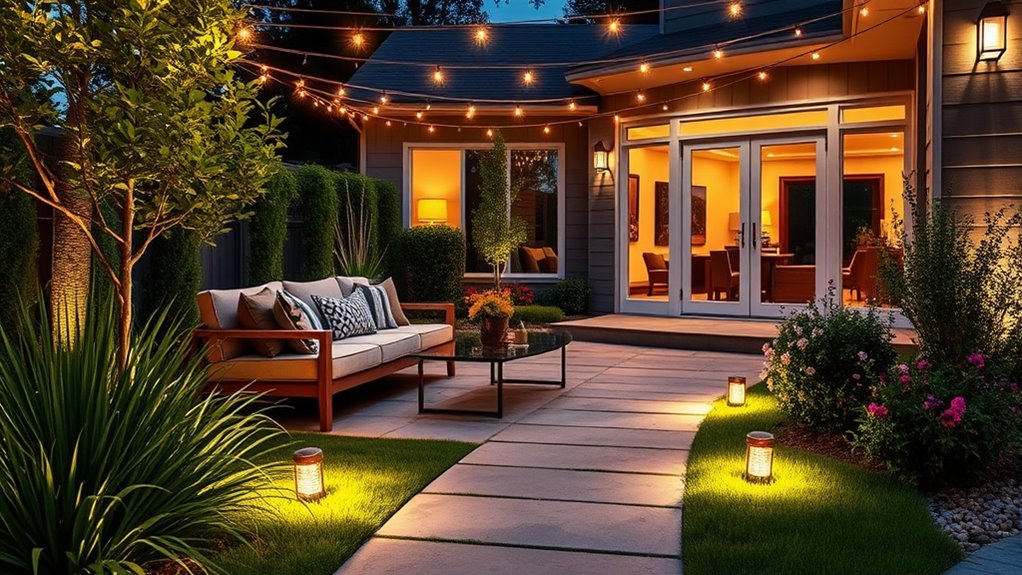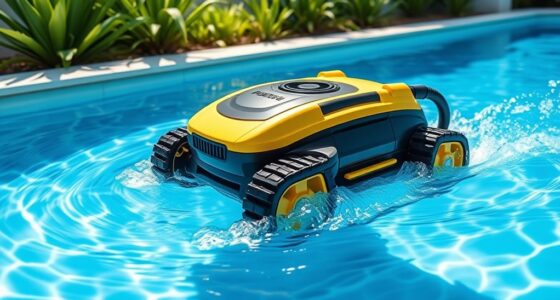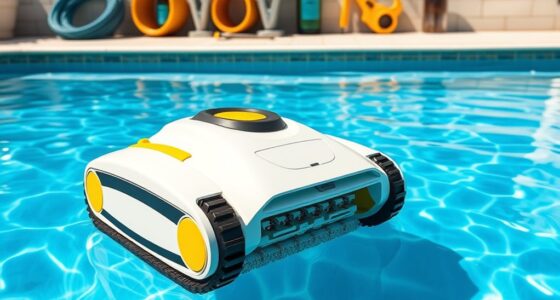Smart outdoor lighting uses LED technology and IoT features to make your evenings safer, more stylish, and eco-friendly. With options like remote control, motion sensors, and smart customization, you can easily set the mood and improve security. These systems also save energy and reduce costs by adjusting brightness based on surroundings. If you want to discover more about these innovative solutions and how to choose the right setup, there’s plenty to explore ahead.
Key Takeaways
- Discover how LED technology combined with IoT enhances energy efficiency and creates customizable, mood-enhancing outdoor lighting experiences.
- Learn about smart features like motion sensors, automated timers, and remote control options for effortless outdoor illumination.
- Explore integration with voice assistants such as Alexa or Google Assistant for hands-free lighting control.
- Understand the benefits of adaptive lighting that responds to environmental conditions, improving safety and aesthetics.
- Consider factors like compatibility, cost, and durability to select the best smart outdoor lighting solutions for your needs.
The Rise of LED Technology in Outdoor Spaces
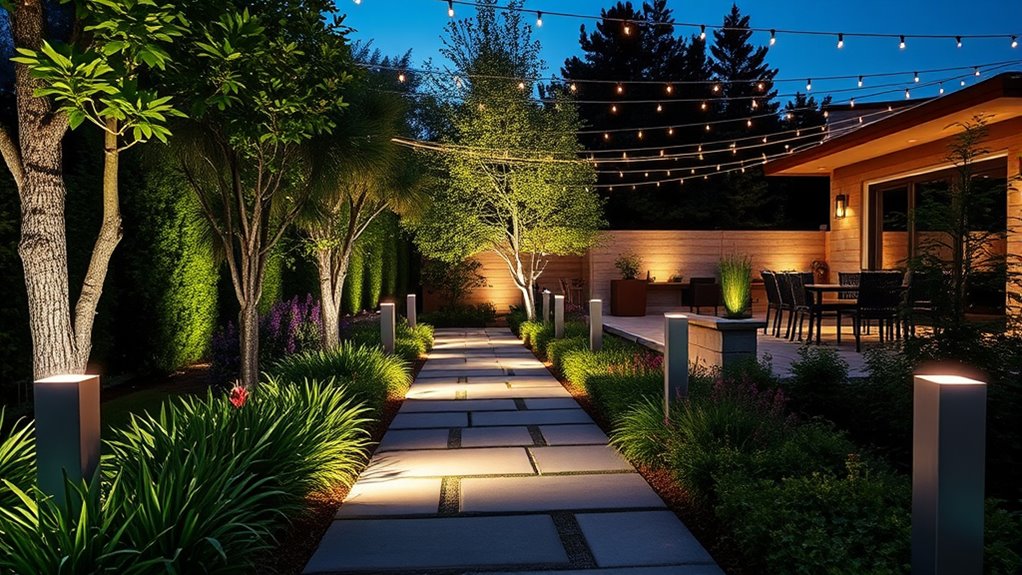
The rise of LED technology has transformed outdoor lighting by offering a more efficient and sustainable solution. Historically, LEDs mark a significant shift from traditional bulbs, symbolizing innovation and progress in urban design. They carry cultural symbolism as symbols of modernity, progress, and environmental responsibility. This technology’s energy efficiency reduces power consumption by up to 90% compared to incandescent bulbs, lowering costs and easing demand on power grids. LEDs also support sustainability goals by decreasing greenhouse gas emissions and containing no toxic materials like mercury. Their longevity, often up to 50,000 hours, minimizes replacements and waste. As a result, municipalities and businesses embrace LEDs to create safer, more aesthetically pleasing outdoor environments—highlighting their cultural and historical importance in shaping sustainable urban landscapes. Additionally, advancements in lighting technology continue to enhance the versatility and effectiveness of outdoor illumination solutions.
How IoT Transforms Outdoor Lighting Systems
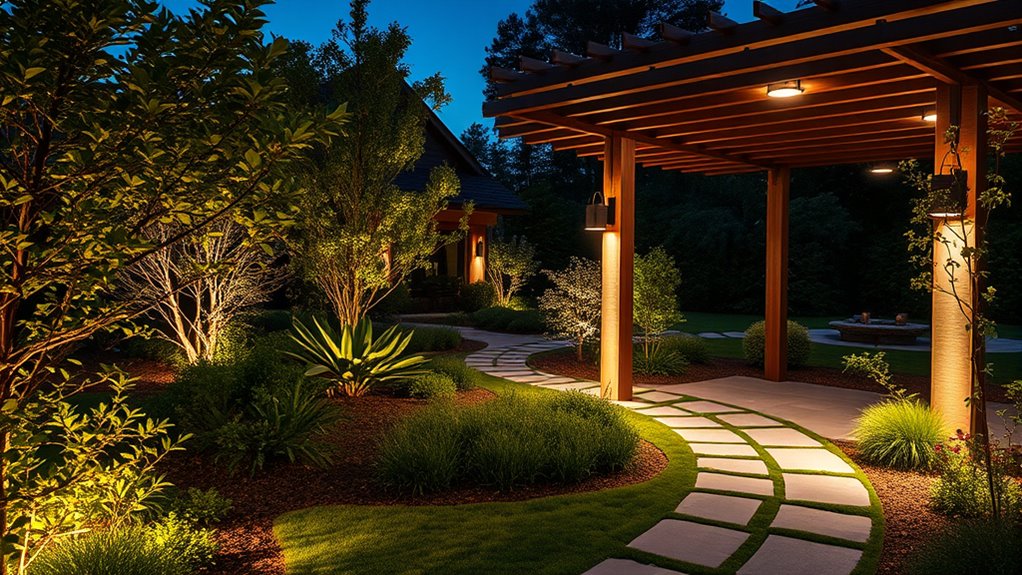
Advancements in IoT technology are revolutionizing outdoor lighting, making systems smarter, more efficient, and more responsive. Historically, outdoor lighting relied on manual controls and basic timers, which limited flexibility and efficiency. Now, IoT overcomes technical challenges by enabling real-time monitoring, automated adjustments, and predictive maintenance. You benefit from systems that dynamically adjust brightness based on environmental conditions like motion and daylight, reducing energy consumption by up to 90%. Cities can precisely deploy lighting where and when needed, optimizing grid use and integrating solar power for sustainability. The integration of solar technology enhances eco-friendliness and reduces reliance on traditional power sources. IoT also enhances reliability with instant fault detection and preemptive repairs, minimizing downtime. This data-driven approach allows for smarter urban planning and improves safety, illustrating how IoT transforms outdoor lighting into a more sustainable, secure, and efficient infrastructure. Additionally, the application of AI in cybersecurity ensures that these connected systems remain protected from potential digital threats, further supporting their reliable operation.
Key Features of Modern Smart Lighting Solutions
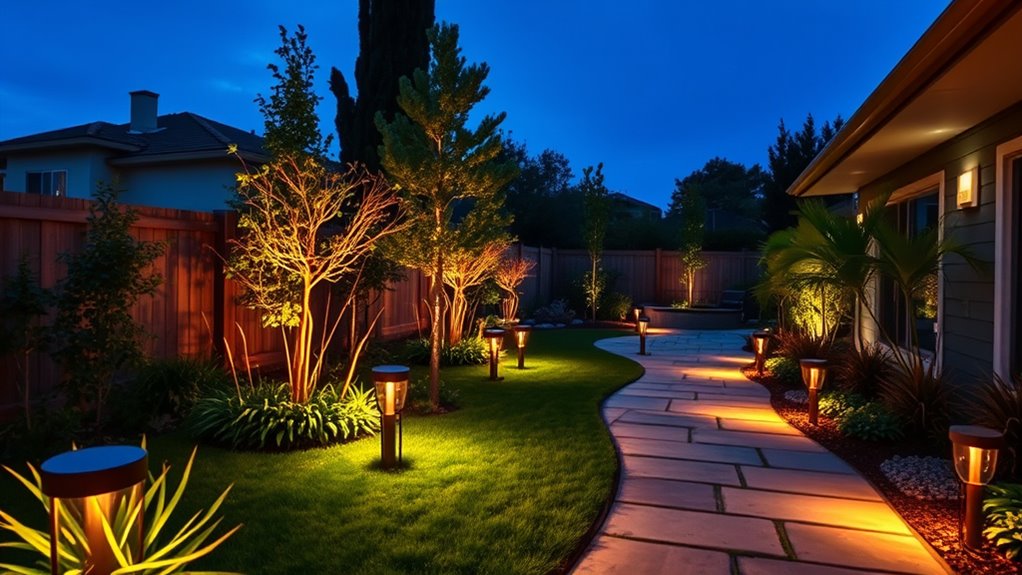
Modern smart outdoor lighting relies on various IoT connectivity options to let you control and customize your system easily. Its dynamic lighting capabilities automatically adjust brightness and color based on environmental conditions or activity. Plus, energy optimization features guarantee you save costs while reducing your environmental impact effortlessly. Connectivity enhances urban safety and efficiency through automated lighting adjustments. Additionally, integrating tuning options can optimize the system’s responsiveness and performance for diverse outdoor environments.
IoT Connectivity Options
Ever wonder how smart outdoor lighting stays connected and responsive? Historical trends show a shift from wired systems to wireless protocols like Wi-Fi, Zigbee, Bluetooth Low Energy (BLE), LoRa™, and cellular networks. Wi-Fi provides direct internet access but consumes more power, while Zigbee and BLE are low-power options with mesh topologies that boost reliability and scalability. LoRa™ covers wide areas with minimal energy, perfect for solar street lights, and cellular connectivity offers centralized control through existing mobile networks. These options support various lighting color schemes, enabling dynamic adjustments and remote management. Mesh networks, especially Zigbee and Bluetooth Mesh, enhance fault tolerance and efficiency, ensuring your outdoor lighting remains reliable, adaptable, and easy to control across diverse environments. Additionally, the integration of Vetted – AP Tuning can optimize the performance and longevity of your lighting systems by ensuring proper calibration and maintenance.
Dynamic Lighting Capabilities
With the rise of smart outdoor lighting, you can now easily control and automate your lighting environment to suit your needs. Dynamic lighting capabilities let you customize colors, from warm white to vibrant hues like red, green, and blue, creating perfect mood lighting for any occasion. You can adjust brightness levels to match different events or preferences, enhancing ambiance effortlessly. Motion sensors activate lights automatically when movement is detected, while dusk-to-dawn sensors ensure your outdoor space is lit at sunset and off at sunrise. With scheduling options, you can tailor lighting patterns to your routines. These features give you full control over your outdoor environment, making it easier to set the right mood, enhance security, and highlight architectural features seamlessly. Advanced control options enable remote management through smartphone apps, voice assistants, and smart home systems, adding even more convenience and flexibility. Additionally, integrating smart lighting systems with other outdoor devices can improve overall functionality and energy efficiency.
Energy Optimization Features
Energy optimization features make smart outdoor lighting even more effective by helping you reduce unnecessary power consumption. Wireless sensors detect motion and occupancy, ensuring lights turn on only when needed and stay off otherwise, saving energy. Automated scheduling and timers allow you to program lighting routines that sync with sunrise, sunset, or your daily habits, preventing waste during unoccupied periods. Dimming and brightness controls adjust lighting intensity based on ambient conditions, reducing excess power use and extending bulb life. LED integration offers up to 80% energy savings compared to traditional bulbs, while real-time energy monitoring provides insights to fine-tune usage. With smart power management, you can remotely control lights, prevent accidental energy drain, and optimize overall efficiency effortlessly. Incorporating industry-specific technology further enhances the effectiveness of these features by providing detailed data to optimize energy consumption.
Enhancing Security and Aesthetics With Smart Lights

Smart outdoor lighting enhances security and aesthetics by providing targeted, adaptable illumination that responds to your surroundings. Historically, installation trends show a shift from static fixtures to integrated smart systems that align with cultural lighting preferences, emphasizing personalized ambiance and safety. These lights connect with motion sensors, triggering brightness only when activity is detected, which deters intruders and reduces unnecessary energy use. Integration with security cameras and real-time alerts boosts surveillance and quick responses. Strategic placement near entry points and dark areas minimizes hiding spots and improves early detection. Automated responses like flashing lights or increased brightness draw attention, discouraging criminal activity. Overall, smart lighting combines functional security features with aesthetic customization, creating a safer, more inviting outdoor space tailored to your style and cultural preferences. Smart technology also allows for remote management, giving you full control over your lighting environment regardless of your location.
Energy Efficiency and Environmental Benefits

Implementing energy-efficient outdoor lighting solutions not only reduces your electricity bills but also minimizes environmental impact. Using LED technology, you can cut energy use by up to 90% compared to traditional bulbs, lowering carbon emissions and light pollution. Smart sensors and daylight sensors adjust brightness based on activity and natural light, reducing waste and over-lighting. Managing color temperature ensures warmer tones that lessen light pollution and preserve night skies. Remote control systems optimize schedules, preventing unnecessary energy consumption. Additionally, understanding color temperature can help you select lighting that minimizes disruption to local wildlife and ecosystems.
Smart Lighting Applications in Urban and Residential Areas
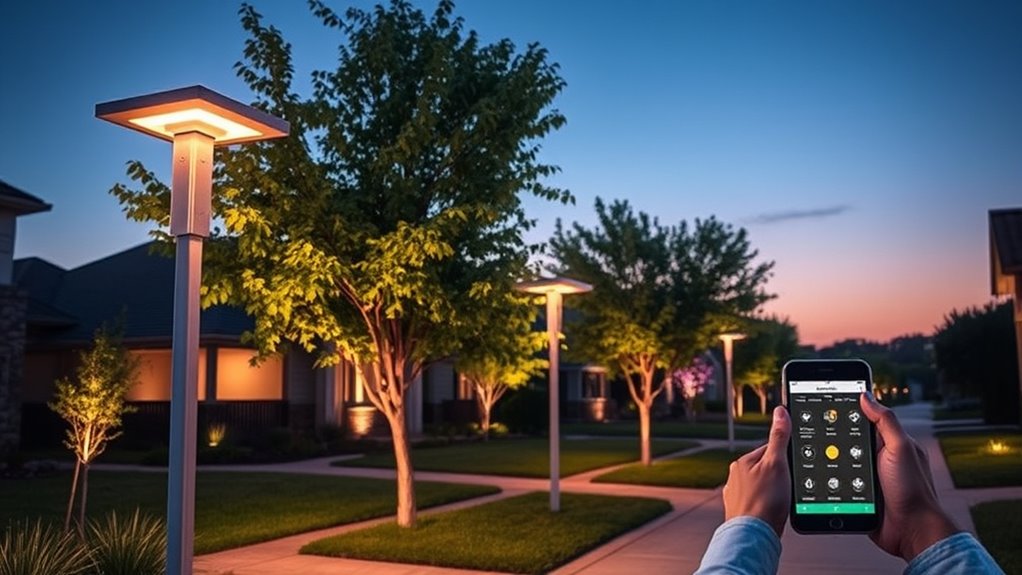
Urban and residential outdoor lighting are increasingly adopting connected technologies to enhance efficiency, safety, and aesthetics. In urban planning, smart lighting helps optimize light distribution, improving visibility for pedestrians and drivers while reducing light pollution. By directing and dimming lights precisely, cities can comply with dark sky regulations and minimize unnecessary brightness. Residential areas benefit from automated, adaptive lighting that boosts security and convenience, allowing you to control settings remotely or schedule scenes. These systems also elevate curb appeal with customizable colors and mood lighting. As smart lighting reduces energy consumption by up to 70%, you’ll enjoy cost savings and a greener environment. Additionally, incorporating environmental considerations ensures that smart lighting supports sustainable development and minimizes ecological impact. Overall, integrating smart lighting in urban and residential spaces creates safer, more appealing communities while supporting sustainable development.
Overcoming Challenges: Costs, Compatibility, and Security

While smart outdoor lighting offers many benefits, it also presents challenges related to costs, compatibility, and security. Cost barriers can be significant, with initial bulbs averaging around $42 and additional expenses like hubs or bridges. Compatibility hurdles arise because different brands use various protocols like Zigbee, Wi-Fi, or Bluetooth, often requiring proprietary hubs that limit cross-brand integration. Some products, especially emerging brands, support fewer ecosystems, complicating setup. To navigate these issues, consider these points:
- Budget-friendly options like Ring Pathlights (~$30) provide security features.
- Premium solutions like Philips Hue come with higher price tags but offer better integration.
- Compatibility depends on your existing smart home ecosystem.
- Firmware updates are essential for maintaining security.
- Long-term savings from energy-efficient LED lights can offset initial costs.
- Recognizing low juice levels in devices can prevent unexpected outages and ensure consistent operation.
Addressing these challenges helps you maximize your smart outdoor lighting experience.
Leading Innovators in Smart Outdoor Illumination

Leading innovators in smart outdoor illumination are shaping the future of outdoor lighting by combining advanced technology with durable design. Companies like RC Lighting deliver high-quality LED fixtures for smart gardens and decorative fixtures, offering reliable global distribution and OEM/ODM services. FX Luminaire focuses on architectural and landscape lighting, emphasizing waterproof and recessed solutions that blend seamlessly into environments. Brands like Oelo provide weather-resistant, long-lasting LEDs with programmable color-changing features, perfect for enhancing outdoor spaces. Solar-powered options and glow stones are eco-friendly innovations that support sustainable outdoor lighting. These companies prioritize durability, energy efficiency, and smart integration, making it easier for you to create stunning, secure, and customizable outdoor environments. Incorporating Cultural Intelligence in product design and customer engagement can help companies better understand and meet diverse consumer needs, fostering trust and loyalty. Their cutting-edge products truly illuminate your evenings with tech-driven style and function.
Future Trends Shaping the Smart Lighting Market
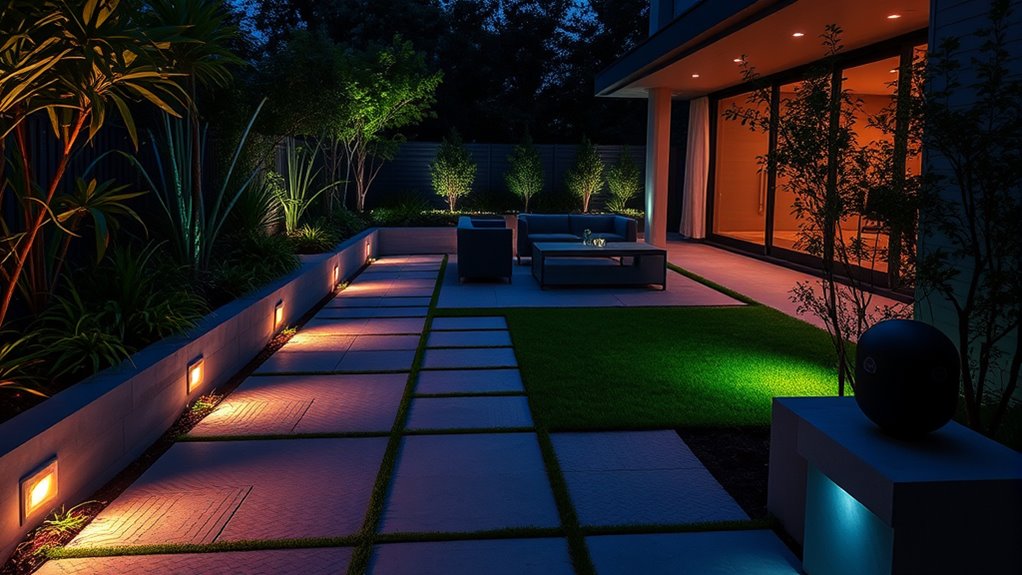
You’ll see IoT and AI become central to smarter, more responsive outdoor lighting systems, allowing for seamless automation and maintenance. Renewable energy sources like solar power will continue to grow, making eco-friendly solutions more practical and widespread. Voice-enabled controls will become standard, giving you easy, hands-free management of your outdoor lighting setup.
IoT and AI Integration
The integration of IoT and AI is revolutionizing outdoor lighting by enabling smarter, more efficient systems. Historically, developments in smart tech have driven these innovations, with newer systems meeting evolving regulatory standards for safety and sustainability. IoT-enabled lights allow remote control, fault detection, and scheduling through centralized dashboards. Sensors dynamically adjust lighting based on traffic, weather, and daylight, reducing waste. Cities like Los Angeles have converted thousands of streetlights, saving energy and costs. AI algorithms analyze usage patterns to optimize brightness and turn off unused lights, while predictive maintenance minimizes downtime. These advancements turn traditional fixtures into data-driven assets, paving the way for future urban sustainability and operational efficiency. Balance sensors can be integrated into outdoor lighting systems to further enhance adaptive control and energy savings.
Renewable Energy Adoption
As the demand for sustainable outdoor lighting grows, renewable energy sources like solar power are shaping the future of smart lighting markets. Solar adoption is accelerating thanks to advances in photovoltaic efficiency, which boost panel output, reduce charge times, and improve reliability. Integrated solar and LED lights become more popular because they’re easy to install—no wiring needed—making them ideal for residential and public spaces. Innovations in battery storage and weather-resistant materials ensure these lights last longer and perform better, even in challenging conditions. Seasonal trends show increased interest in solar garden lights during spring and summer. Moreover, energy-efficient technology continues to evolve, further enhancing the effectiveness and sustainability of outdoor lighting solutions. By embracing renewable energy, you help reduce energy consumption and contribute to a more resilient outdoor lighting infrastructure capable of weather resilience and sustainability.
Voice-Enabled Controls
Voice-enabled controls are transforming outdoor lighting by allowing seamless, hands-free operation through popular assistants like Alexa, Google Assistant, and Siri. Historically, this trend reflects the shift toward more intuitive, user-centric smart home technology, influenced by cultural preferences for convenience and automation. Today’s voice controls let you adjust brightness, colors, and lighting patterns effortlessly. You can also automate schedules, enhancing energy efficiency and security. Additionally, smart technology enables remote monitoring and management, providing even greater convenience. – Control lights without lifting a finger – Customize lighting with simple commands – Automate routines for convenience – Integrate with smart home systems – Adapt lighting based on cultural events and preferences As voice technology advances, future trends will focus on AI personalization and deeper integration, making outdoor lighting smarter, more responsive, and culturally adaptable.
Tips for Choosing the Right Smart Outdoor Lighting System
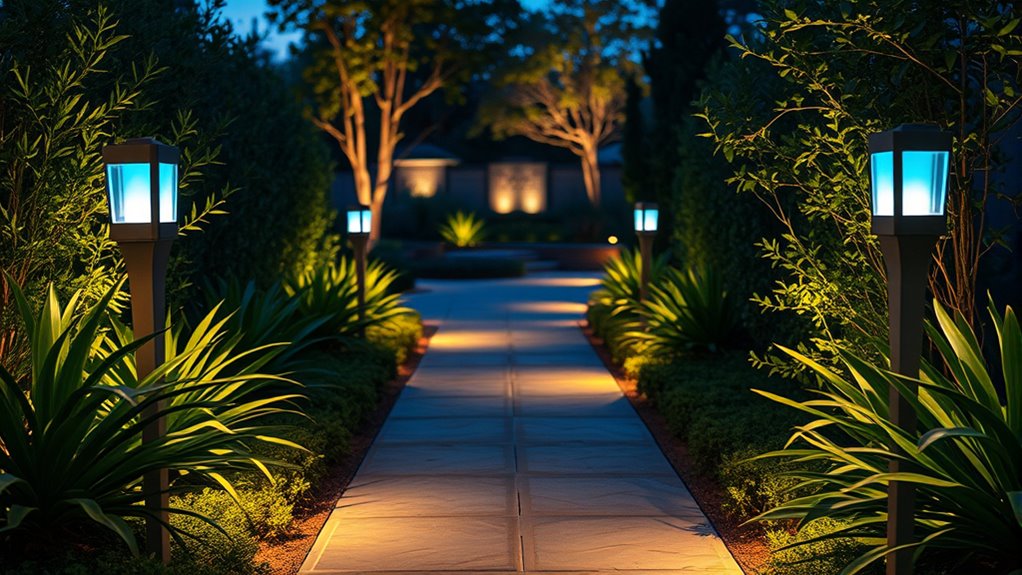
Choosing the right smart outdoor lighting system depends on your specific needs and preferences. Consider how historical lighting and cultural influences shape your aesthetic choices—some styles evoke classic charm, while others favor modern minimalism. If you want a simple setup, solar-powered lights are eco-friendly and easy to install, but they may lack brightness and depend on weather. Wired systems offer reliable power but often require professional installation. LED technology provides energy efficiency and customizable color temperatures, letting you create different moods. For advanced control, systems like Casambi support wireless networking and remote management, aligning with your lifestyle. Think about your space size, desired features, and budget to select a system that enhances your outdoor environment while reflecting your personal style. Regularly checking your bicycle tires for wear and proper inflation can also ensure safe and reliable use of your bike during outdoor activities.
Frequently Asked Questions
How Secure Are Iot-Enabled Outdoor Lighting Systems Against Hacking?
You might wonder how secure IoT-enabled outdoor lighting systems are against hacking. Cybersecurity threats and data privacy risks are significant because these devices connect to multiple networks, often with weak security measures like default passwords and insecure protocols. Without proper network segmentation, device hardening, and regular updates, your outdoor lighting could be vulnerable to attacks, exposing personal data and compromising your property’s safety. Always prioritize robust security practices to protect your smart lighting.
Can Smart Outdoor Lights Be Integrated With Existing Home Automation Systems?
You can definitely integrate smart outdoor lights with your existing home automation system. Focus on compatibility and integration compatibility between the lights and your control platform. Make sure the user interface is seamless and easy to operate, whether through apps or voice commands. Check that the lighting supports your preferred communication protocol like Wi-Fi, Zigbee, or Z-Wave. Proper setup guarantees smooth control, automation, and a cohesive smart home experience.
What Is the Typical Lifespan of Smart Outdoor LED Lighting Fixtures?
You’ll find that the typical lifespan of smart outdoor LED lighting fixtures ranges from 15,000 to 50,000 hours, depending on bulb durability and usage. To maximize their lifespan, you should reduce maintenance frequency by regularly cleaning and checking connections. Environmental factors like weather also matter, so choosing high-quality products and installing them properly can make a big difference in how long they last.
Are There Eco-Friendly Options for Solar-Powered Smart Outdoor Lighting?
You might think all solar lighting harms the environment, but eco-friendly options prove otherwise. Solar alternatives use high-efficiency solar panels and LED bulbs, appreciably reducing emissions. Some models incorporate biodegradable materials, decreasing waste. By choosing smart outdoor lighting with these features, you enhance sustainability, conserve energy, and minimize your ecological footprint. It’s a smart way to enjoy outdoor illumination while supporting eco-conscious innovations that prioritize long-term environmental health.
How Does Weather Impact the Performance of Outdoor Smart Lighting?
Weather impacts outdoor smart lighting by challenging its weather resistance and lighting durability. Cold temperatures slow reactions, dimming lights and delaying startup, while heat can cause overheating and shorten lifespan. Moisture, snow, and humidity risk damage if enclosures aren’t sealed properly. Advanced systems with moisture sensors and weather adaptive tech help protect fixtures, ensuring consistent performance despite weather fluctuations. Proper design and maintenance are key to maximizing durability and reliable illumination.
Conclusion
So, now that you’re armed with all the tech-savvy tips, why settle for dull, boring outdoor lighting? With smart lights, you’ll turn your yard into a high-tech paradise—complete with security, style, and maybe even a little envy from neighbors. Just remember, the only thing smarter than your lighting system will be you, once you realize you can control your outdoor glow from your couch. Who knew illumination could be so clever?
